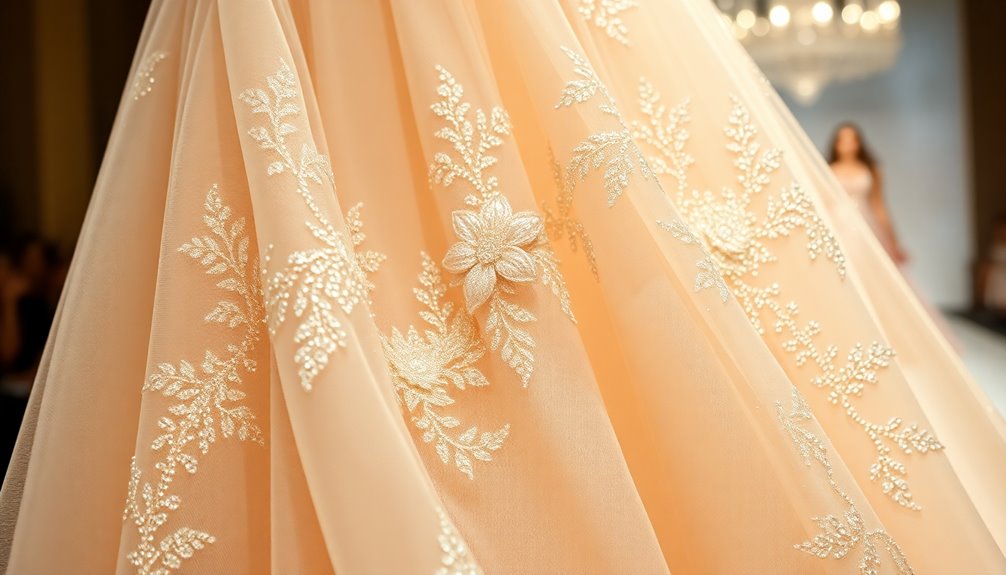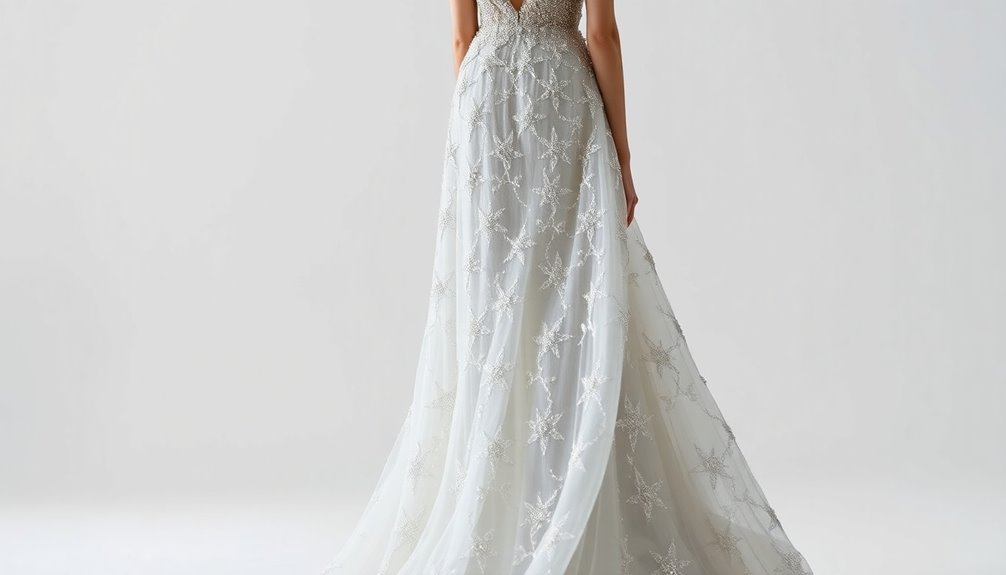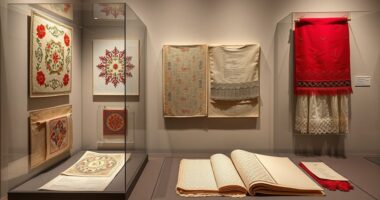Haute couture, translating to "high sewing" in French, signifies a prestigious category of fashion defined by exclusive, custom-fitted clothing primarily produced in Paris. Each piece exhibits exceptional craftsmanship, luxurious materials, and meticulous attention to detail, reflecting an artistic vision. Established in the mid-19th century by pioneers like Charles Frederick Worth, haute couture is regulated by the Chambre Syndicale de la Haute Couture, ensuring that only eligible houses produce authentic pieces. Designers must present at least 25 original creations biannually during Paris Couture Week, where fashion transforms into art. There's much more to explore about this fascinating world of high fashion.
Key Takeaways
- Haute couture refers to exclusive, custom-fitted clothing primarily crafted in Paris, emphasizing luxury and high-quality materials.
- The term is legally protected in France, with strict criteria set by the Chambre Syndicale de la Haute Couture.
- Origins date back to the mid-19th century, with Charles Frederick Worth considered the founder of modern haute couture.
- Fashion houses must present a minimum of 25 original designs biannually during Paris Couture Week to maintain eligibility.
- Haute couture shopping offers a personalized experience, often involving one-on-one consultations with designers for bespoke tailoring.
Definition and Characteristics
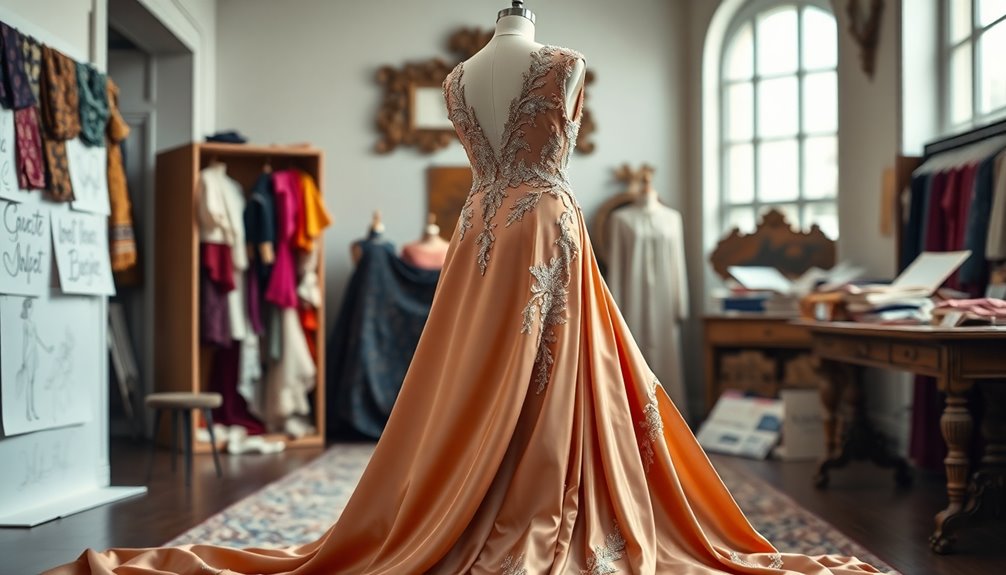
Haute couture, often seen as the pinnacle of fashion, translates to "high sewing" or "high dressmaking" and represents exclusive, custom-fitted clothing crafted primarily in Paris. This prestigious segment of the fashion industry is characterized by its luxury and craftsmanship, guaranteeing that each piece is tailored specifically for wealthy clients.
The garments are made from high-quality, expensive fabrics that showcase meticulous attention to detail, often incorporating time-consuming, hand-executed techniques that highlight the artistry involved in creating these exclusive designs.
To be recognized as haute couture, fashion houses must adhere to strict criteria set by the Chambre Syndicale de la Haute Couture. This includes the requirement to present a minimum of 25 original designs biannually, reinforcing the notion of originality and innovation in high sewing.
Each creation isn't only a garment but also a unique design experience, tailored to fit the individual client perfectly. The focus on craftsmanship guarantees that every piece embodies the highest standards of quality and artistic expression, making haute couture a true reflection of luxury fashion.
Through this dedication to detail, haute couture continues to captivate the elite, reinforcing its status as a hallmark of fashion excellence.
Historical Origins
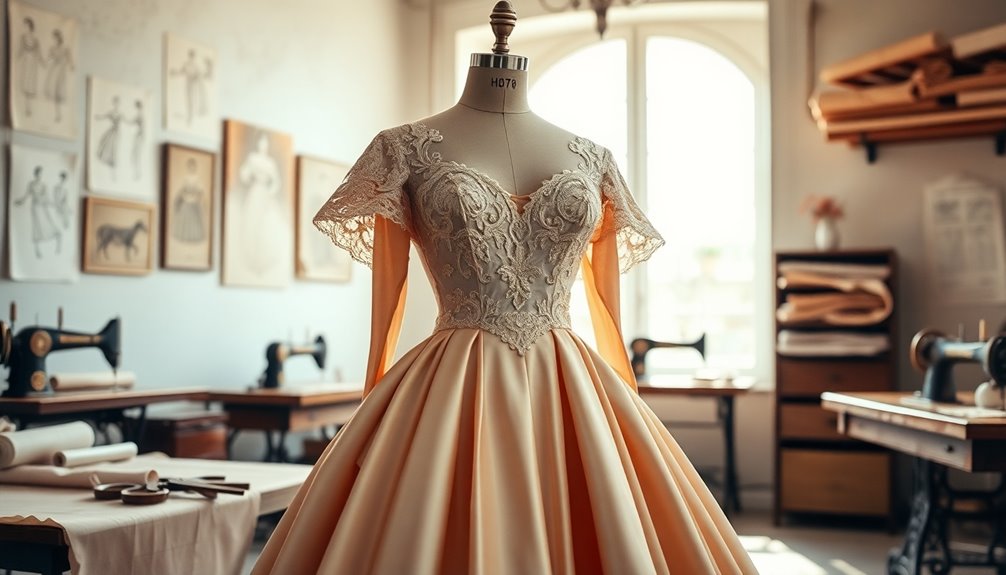
The origins of haute couture trace back to mid-19th century Paris, where Charles Frederick Worth established the first true couture house in 1858. Worth revolutionized fashion design by introducing the idea of creating bespoke garments tailored specifically for wealthy patrons. His work laid the groundwork for a new industry that would flourish in the fashion capitals of the world.
The development of haute couture was influenced by several factors:
- The aftermath of the French Revolution led to a shift in clothing consumption, with the rising bourgeoisie seeking unique, luxurious attire.
- Rose Bertin, the "Minister of Fashion" for Queen Marie Antoinette, helped elevate the status of haute couture in society.
- Empress Eugénie, a key patron, solidified haute couture's reputation as an esteemed art form.
In 1945, the Chambre Syndicale de la Haute Couture was established to regulate the term "haute couture," setting legal standards for those who could claim this prestigious title.
This guaranteed that the craftsmanship and exclusivity of haute couture would be preserved, solidifying its place in the annals of fashion history. Understanding these historical origins enhances your appreciation for the artistry and significance of haute couture today.
Regulatory Framework
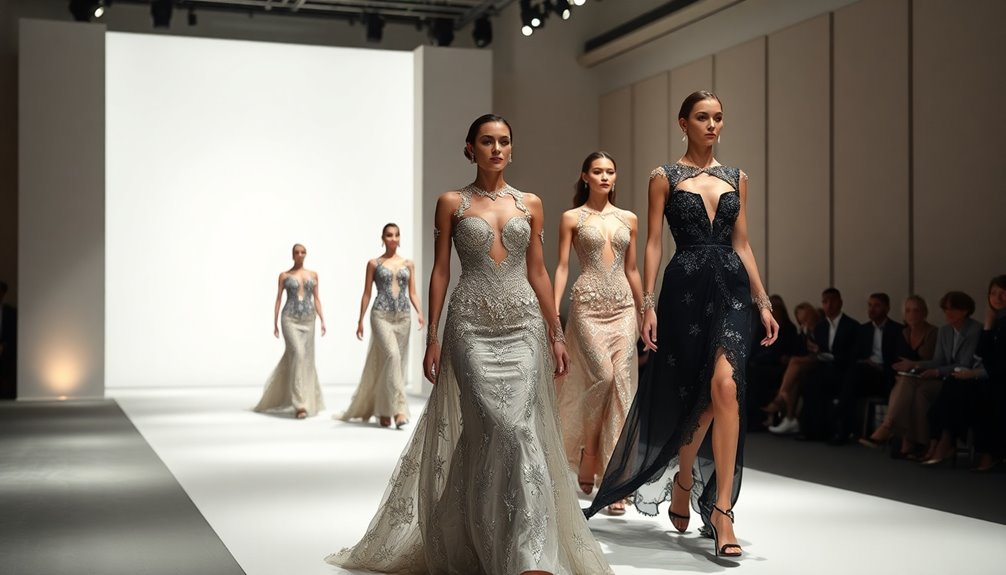
Regulations surrounding haute couture play an important role in maintaining its exclusivity and craftsmanship. The term "haute couture" isn't just a fancy label; it's legally protected in France, which means only qualified fashion houses can use it.
The Paris Chamber of Commerce has established specific criteria that these couture houses must meet, ensuring they uphold the highest standards of quality.
The Fédération de la Haute Couture et de la Mode oversees the eligibility of these houses, making sure they adhere to the regulatory framework. To be recognized, designers must create made-to-order garments for private clients and maintain a workshop in Paris with at least 20 full-time artisans.
Additionally, each couture house is required to present a minimum of 25 original designs biannually during Paris Couture Week, held in January and July.
This framework not only protects the integrity of haute couture but also combats the misuse of the term by non-compliant brands, which can dilute its meaning in popular culture.
Consequently, adherence to these regulations is vital for preserving the artistry and prestige associated with haute couture fashion.
Fashion Shows and Events
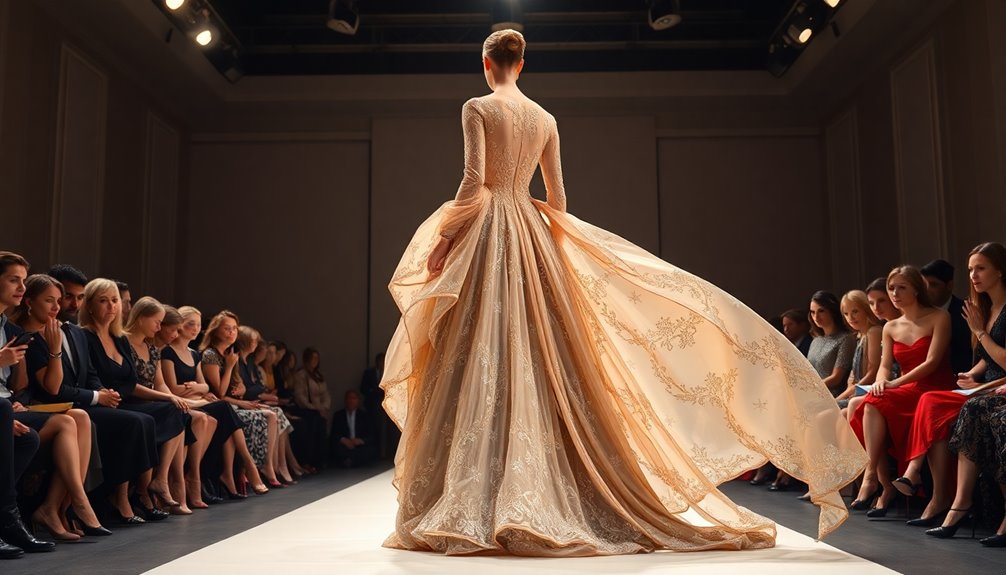
While attending a haute couture fashion show, you can't help but be captivated by the blend of intricate garments and theatrical presentations that define this exclusive world.
Haute Couture week, held biannually in January and July, showcases the latest collections from elite fashion houses to an exclusive audience of affluent buyers and industry insiders. Notable venues, such as the Palais Garnier and the Musée Yves Saint-Laurent, enhance the luxury experience, immersing you in a world where craftsmanship and artistry reign supreme.
These fashion shows not only highlight the intricate designs but also serve as significant marketing platforms for brands, drawing substantial media attention.
Celebrities often don haute couture pieces at high-profile events like the Met Gala, further elevating the status of the showcased designs. The theatricality of these events captivates attendees, transforming garments into storytelling elements.
- Unique combination of fashion and art
- Exclusive access for select attendees
- High-profile media coverage and celebrity appearances
In essence, haute couture fashion shows represent a pinnacle of luxury and creativity, celebrating the artistry that defines this extraordinary sector of the fashion industry.
Shopping Experience
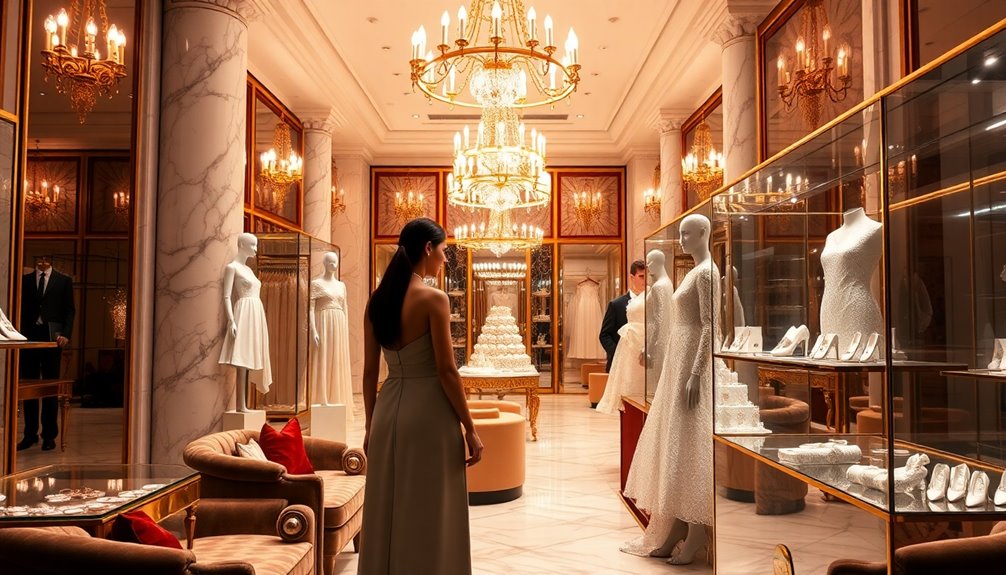
Immersing yourself in the haute couture shopping experience is unlike any other, offering a blend of exclusivity and personalization that truly sets it apart.
Located in prestigious locations like the Triangle d'Or in Paris, where luxury brands such as Gucci, Balmain, and Louis Vuitton reside, these boutiques create a luxurious ambiance that enhances your experience.
When you enter a haute couture store, you’re greeted with intricate designs and costly garments that reflect the highest level of craftsmanship. However, the truth about haute couture goes beyond the extravagant price tags and luxurious displays. It is about the dedication of skilled artisans who pour their creativity and expertise into every piece. Each garment is meticulously handcrafted, ensuring that it is not only a beautiful work of art, but also a symbol of precision and attention to detail. The truth about haute couture is that it represents the pinnacle of fashion craftsmanship and individuality.
The shopping experience often includes one-on-one consultations with designers or stylists, ensuring that each piece is tailored to your individual preferences and embodies a bespoke design.
Private shopping tours are also available for those seeking a more personalized approach, allowing you to explore exclusive collections while receiving tailored services.
This unique experience combines fashion with art, as you witness the meticulous details and artistry that go into each creation.
Essentially, haute couture shopping is a journey into the world of luxury, where your desires and the finest fashion converge, making it an unforgettable chapter in your style narrative.
Frequently Asked Questions
What Qualifies as Haute Couture?
To qualify as haute couture, a fashion house must create made-to-order garments for private clients, ensuring each piece is unique and meticulously crafted.
It's essential for the designer to operate an atelier in Paris, employing at least 20 full-time artisans.
In addition, they need to present a minimum of 25 original designs twice a year during Paris Couture Week.
Only a select few, like Dior and Chanel, achieve this prestigious status.
What Is the Difference Between High Fashion and Haute Couture?
High fashion and haute couture differ primarily in exclusivity and production methods.
While high fashion encompasses a broader range of designer-branded items, including luxury ready-to-wear, haute couture is strictly custom-made, adhering to specific regulations set by the Chambre Syndicale de la Haute Couture.
Haute couture garments, crafted with meticulous attention to detail, are typically more expensive, often costing tens of thousands of dollars, emphasizing their unique and personalized nature compared to high fashion items.
What Does It's Haute Couture Mean?
When you hear "it's haute couture," think of a rare gem, meticulously crafted and uniquely designed.
This term signifies exclusive fashion, representing garments tailored specifically for an individual, made from luxurious fabrics.
Each piece undergoes detailed fittings, ensuring an impeccable fit.
Only elite fashion houses, recognized by the Chambre Syndicale de la Haute Couture, can use this label, emphasizing the artistry and precision involved in haute couture, akin to a masterful painting in the world of fashion.
What Does so Haute Couture Mean?
So haute couture refers to high-end fashion that emphasizes exclusivity and craftsmanship.
It involves custom-fitted garments created specifically for private clients, often using rare fabrics and intricate hand-executed techniques.
Only a few fashion houses, like Dior and Chanel, are officially recognized under this label, which requires designers to produce a minimum of 25 original designs biannually and employ at least 20 full-time artisans.
This meticulous process elevates haute couture to a unique art form.
